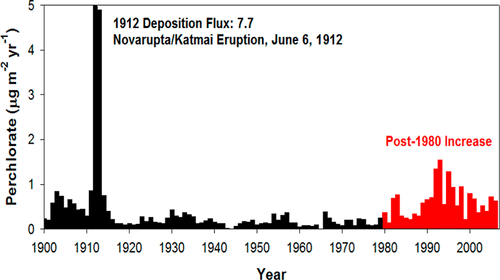当前位置:
X-MOL 学术
›
Environ. Sci. Technol.
›
论文详情
Our official English website, www.x-mol.net, welcomes your
feedback! (Note: you will need to create a separate account there.)
Evidence of Influence of Human Activities and Volcanic Eruptions on Environmental Perchlorate from a 300-Year Greenland Ice Core Record
Environmental Science & Technology ( IF 10.8 ) Pub Date : 2018-07-09 , DOI: 10.1021/acs.est.8b01890 Jihong Cole-Dai 1 , Kari M. Peterson 1 , Joshua A. Kennedy 1 , Thomas S. Cox 2 , David G. Ferris 3
Environmental Science & Technology ( IF 10.8 ) Pub Date : 2018-07-09 , DOI: 10.1021/acs.est.8b01890 Jihong Cole-Dai 1 , Kari M. Peterson 1 , Joshua A. Kennedy 1 , Thomas S. Cox 2 , David G. Ferris 3
Affiliation

|
A 300-year (1700–2007) chronological record of environmental perchlorate, reconstructed from high-resolution analysis of a central Greenland ice core, shows that perchlorate levels in the post-1980 atm were two-to-three times those of the pre-1980 environment. While this confirms recent reports of increased perchlorate in Arctic snow since 1980 compared with the levels for the prior decades (1930–1980), the longer Greenland record demonstrates that the Industrial Revolution and other human activities, which emitted large quantities of pollutants and contaminants, did not significantly impact environmental perchlorate, as perchlorate levels remained stable throughout the 18th, 19th, and much of the 20th centuries. The increased levels since 1980 likely result from enhanced atmospheric perchlorate production, rather than from direct release from perchlorate manufacturing and applications. The enhancement is probably influenced by the emission of organic chlorine compounds in the last several decades. Prior to 1980, no significant long-term temporal trends in perchlorate concentration are observed. Brief (a few years) high-concentration episodes appear frequently over an apparently stable and low background (∼1 ng kg–1). Several such episodes coincide in time with large explosive volcanic eruptions including the 1912 Novarupta/Katmai eruption in Alaska. It appears that atmospheric perchlorate production is impacted by large eruptions in both high- and low-latitudes, but not by small eruptions and nonexplosive degassing.
中文翻译:

人类活动和火山喷发对300年格陵兰冰芯记录的环境高氯酸盐影响的证据
根据对格陵兰中部冰芯的高分辨率分析重建的300年(1700-2007年)环境高氯酸盐时间记录显示,1980年后大气压下的高氯酸盐水平是前大气压的2至3倍。 1980年的环境。尽管这证实了最近的报道,即自1980年以来北极雪中高氯酸盐的含量与之前几十年(1930-1980年)的水平相比有所增加,但格陵兰岛较长的记录表明,工业革命和其他人类活动散发出大量污染物和污染物,没有显著影响环境的高氯酸盐,氯酸盐水平在整个18保持稳定日,19日,和许多20次个世纪。自1980年以来的增加水平可能是由于大气中高氯酸盐产量的增加,而不是由于高氯酸盐生产和应用的直接释放。近几十年来,这种增强可能受到有机氯化合物排放的影响。在1980年之前,未观察到高氯酸盐浓度的长期长期显着趋势。短暂(数年)的高浓度发作经常出现在表面稳定且背景较低的环境中(约1 ng kg –1)。几个这样的事件在时间上与大型爆炸性火山爆发相吻合,包括1912年阿拉斯加的Novarupta / Katmai爆发。看来高纬度和低纬度的大爆发影响了大气高氯酸盐的产生,但小爆发和非爆炸性脱气却没有影响。
更新日期:2018-07-10
中文翻译:

人类活动和火山喷发对300年格陵兰冰芯记录的环境高氯酸盐影响的证据
根据对格陵兰中部冰芯的高分辨率分析重建的300年(1700-2007年)环境高氯酸盐时间记录显示,1980年后大气压下的高氯酸盐水平是前大气压的2至3倍。 1980年的环境。尽管这证实了最近的报道,即自1980年以来北极雪中高氯酸盐的含量与之前几十年(1930-1980年)的水平相比有所增加,但格陵兰岛较长的记录表明,工业革命和其他人类活动散发出大量污染物和污染物,没有显著影响环境的高氯酸盐,氯酸盐水平在整个18保持稳定日,19日,和许多20次个世纪。自1980年以来的增加水平可能是由于大气中高氯酸盐产量的增加,而不是由于高氯酸盐生产和应用的直接释放。近几十年来,这种增强可能受到有机氯化合物排放的影响。在1980年之前,未观察到高氯酸盐浓度的长期长期显着趋势。短暂(数年)的高浓度发作经常出现在表面稳定且背景较低的环境中(约1 ng kg –1)。几个这样的事件在时间上与大型爆炸性火山爆发相吻合,包括1912年阿拉斯加的Novarupta / Katmai爆发。看来高纬度和低纬度的大爆发影响了大气高氯酸盐的产生,但小爆发和非爆炸性脱气却没有影响。











































 京公网安备 11010802027423号
京公网安备 11010802027423号